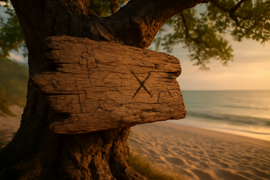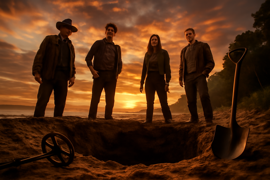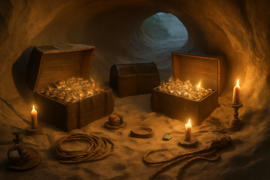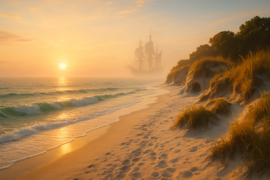Introduction
The whisper of wind over white sands carries a secret older than any living memory at Crystal Beach. Local fishermen speak of ships that vanished in sudden storms and treasures buried under dunes by desperate sailors. On evenings when the tide retreats to reveal pale shoals, visitors claim glimpses of tarnished gold coins glittering beneath shallow surf. Yet no one has ever recovered more than a handful of Spanish doubloons—or even proved their existence beyond rumor.
For centuries the legends have grown, handed down in hushed tones among families who call the Gulf Coast home. Each generation adds new details: a torn sail-cloth flapping in the reeds, a mysterious cave mouth glimpsed at low tide, or a carved stone marker barely visible above the line of dunes. Storytellers recount a battered schooner crewed by intrepid conquistadors who fled across the Atlantic in search of new wealth. Fleeing pirates and illness, they hid their most precious cargo on a deserted beach before vanishing into the wilderness.
In contemporary times, fanciful tales of buried treasure often lead to disappointed tourists and unpaid excavators. But for Elena Vargas, an independent historian with roots in Andalusia, the legend of Crystal Beach holds a stubborn kernel of truth. Armed with a fragmentary 16th-century map, dusty archival records, and local oral histories, she arrives in the small seaside town determined to prove that some legends are based on real events. Yet every step reveals more questions: who left the map behind, why did the sailors choose this particular stretch of sand, and what fate befell the expedition that refused to be forgotten?
As the sun dips toward the horizon each evening, casting long shadows over the dunes, Elena stands on the brink of discovery. Her research has led her here, to a place where the roar of surf and creak of palm fronds form a symphony of clues. But Crystal Beach is not merely a site of colonial ambition and buried riches. It is a landscape shaped by shifting tides, hidden groves, and the restless echoes of those who risked everything. To unlock the treasure’s location, Elena must piece together fragments of a story told in languages both ancient and local, in journals scrawled by fever-weak hands and legends kept alive by grandchildren of early settlers.
Under the golden glow of dusk, with gulls wheeling overhead and salt spray on the breeze, the stage is set. The sands of Crystal Beach have been waiting for a seeker both patient and bold. Every grain seems to hold a memory, a secret, a promise. As Elena traces aged ink lines on her map, she knows the real journey is just beginning—the quest to bring lost treasure into the light and to restore a forgotten chapter of history.
Origins of the Legend
In the year 1567, Spanish pilot Diego Marín set sail from Veracruz with a hold full of newly minted gold coins, fine silks, and precious gems bound for Havana. Storms battered his ship, La Esperanza, forcing an unscheduled stop along an unfamiliar shore. According to a battered logbook later discovered in a crumbling convent in Seville, Marín and his crew stumbled onto what we now call Crystal Beach. The sailors were starving, the hull leaking, and their Spanish commander gravely ill with fever. The precious cargo could not risk the sea’s wrath, so a desperate decision was made: bury the treasure in the sand and send a small party inland for help, leaving the map’s instructions carved on driftwood.

Marín’s party ventured into the thick forests beyond the dunes, only to be ambushed by rival pirates who had tracked their ship by its unusual flag. Few men escaped to relay the story. The survivors buried their wounded captain beneath a canopy of pines and returned to La Esperanza, only to find the vessel boarded and plundered. The treasure was gone, and so was the ship, lost beneath a sudden squall that tore it from its anchors. Word of the burial site survived in fragments: a single copper doubloon washed ashore, a torn fragment of Marín’s driftwood map recovered by a local fisherman, and scattered whispers passed among coastal villages.
Over the centuries, French Huguenot refugees, British colonial settlers, and early American pioneers all encountered references to the same buried fortune. In 1704, a Frenchman named Étienne Leclerc claimed to have discovered a hidden cavern draped with spider silk and filled with crates of gilt-edged coins. He excavated only a handful of pieces before the cavern collapsed. Leclerc never returned to France; his fate remains a mystery, but journals purportedly in a Paris museum detail the partial find and hint at a larger stash still waiting.
By the late 19th century, local newspapers ran sensational headlines about treasure hunters drilling through dunes and diverting creeks. One enterprising prospector even built a wooden sluice pit to wash sand for gold flakes, convinced that Marín’s men had secreted valuable artifacts rather than coinage. Each expedition ended in disappointment, equipment lost to shifting tides or crippling fines for trespassing. Yet every failure fed the legend—maps multiplied, divers swapped tales of shimmering metal beneath shallow water, and scores of relics washed ashore: rusted swords, silver rosaries, and fragments of Spanish armor.
Into this tapestry of half-truths and tall tales stepped the first serious scholar, Archibald P. Finch, in 1924. Finch combined archival research with field notes from local families whose ancestors had guarded the legend as a sacred trust. He traced the story back to Marín’s original landfall through a sequence of coded symbols on driftwood postcards exchanged among coastal postmasters. His handwritten manuscript, long lost in the archives of a Gulf Coast historical society, detailed a likely creek bed that once ran beneath the dunes and fed a freshwater spring marking the burial site. Finch’s notes vanished decades ago, fueling speculation that modern developers had quietly bought and shelved the documents to avoid excavation claims.
Today, Elena Vargas stands on the shoulders of these early chroniclers. She has studied Finch’s references, collated prize pieces from private collections, and cross-referenced Spanish naval records. The legend’s origins may lie in desperation and fear, but they also spring from human courage and ingenuity. Each maritime disaster, each secret meeting in moonlit coves, each torn parchment all add chapters to a living story that refuses to be buried. And for the first time in more than four centuries, the pieces seem to align.
With her research mapped and local guides assembled, Elena knows where to search. She stands at the spot Finch predicted—a flat stretch of sand flanked by dune grass and backed by an ancient oak grove. The wind rustles through the oak’s low branches, as though whispering, “Dig here, but be wary.” Underneath that oak lies the heart of the legend: a cache of gold, silver, and emerald-inlaid goblets waiting for someone with the resolve to unearth them. Yet even as she prepares to unearth this secret, she feels the weight of history pressing down—reminders that countless others have tried and failed. Still, the promise of discovery stirs her courage.
In these ancient dunes, the forces of nature and fate converge. The tide shifts, erasing footprints and revealing new contours. A single moonlit night could change everything. For Elena and her companions, the origins of the legend are not merely prologue—they are a living part of the journey that will carry them into darkness, into trembling hope, and perhaps into triumph.
Quest for Clues
The next morning, Elena gathered her small team at dawn beneath the oak grove. Her companions included local historian Marcus Reed, adept at translating colonial Spanish accounts; marine geologist Dr. Aisha Khan, whose specialty lay in mapping subterranean caves; and college student Javier Morales, whose family had lived on the Gulf coast for generations, preserving whispered tales of ghostly figures among the dunes. Each brought a different lens to the quest, but all shared reverence for the legend’s depth.

They set out with metal detectors, ground-penetrating radar equipment, and the original Finch notes—meticulously recreated from surviving fragments. The sun rose over a calm sea, painting the sky in pastel hues, as they identified three likely target zones: a stretch of sand near a collapsed sandbar, a shallow lagoon cut by an old creek, and a rocky outcrop half-buried in driftwood and sea grass. The air smelled of salt and wild rosemary, and gulls wheeled aloud overhead, carrying distant cries that sounded almost like warnings.
In zone one, sonar scans revealed a cavity buried ten feet below the surface. With careful measured digging and shoring, the team cleared sand until they reached a stone slab carved with a cross and a fleur-de-lis—symbols tied to the royal Spanish house. Underneath lay two wooden chests, centuries old and sealed with rusted iron bands. Their planks creaked as Dr. Khan gently pried them open, revealing tarnished goblets, rust-pitted swords, and leather-bound ledgers with faded ink. Excitement surged, but then the floor beneath them trembled—water seeped in, pressure building. They backed away, sealing the chests and marking the coordinates.
At the lagoon site, they discovered an entrance to a collapsed cavern. Using ropes and hard hats, they lowered a waterproof lamp and spotted faded frescoes on the walls—mariner’s prayers, rosaries carved into limestone, and sketched outlines of sailing ships. Two chests lay half-submerged in silt, sealed in tar to keep out moisture. Javier ventured inside to retrieve them, emerging triumphantly with pieces of heavy bullion. But on the cavern walls, fresh claw marks suggested that creatures—perhaps wild boar or something more elusive—made this place their den. They retrieved only what they could carry safely.
The final zone, the rocky outcrop, proved the toughest. Blisters formed on hands as the group chipped away at sandstone to reveal hidden alcoves. One alcove contained a brass astrolabe encrusted with barnacles, its mirror cracked but the star alignment rings intact. Another held a leather pouch of gold escudos threaded through a metal chain. As they cataloged each artifact, Elena realized they were unearthing not merely a single hoard but evidence of multiple caches—perhaps hidden by panicked crewmembers at different times.
As dusk approached, the team laid out their finds around a fire lit against the ocean breeze. They sorted coins by mint date, noting the earliest from 1566 and the latest from 1573—suggesting the treasure accumulated over years. Dr. Khan sketched a new map marking each discovery. Marcus read aloud entries from a recovered ledger, recounting how Marín’s captain ordered certain chests marked for the crown and others for private profit. The ledger hinted at a final cache still undiscovered—“the crown’s prize,” it called it, sealed in a chamber beneath crisscrossed roots of a banyan tree.
The mention of a banyan tree puzzled them; none grew naturally along the Gulf coast. But Javier recalled a legend of a long-forgotten garden planted centuries ago by settlers near a freshwater spring. That spring, Finnch had noted, once ran inland past the dunes. The next morning, they would follow its dried bed toward a shallow pond flanked by two centuries-old boulders—a location that matched both ledger notes and local lore.
Through sleepless nights and blistered hands, Elena and her team persisted. Each clue deepened the mystery, testing their resolve and forging camaraderie. They faced unexpected challenges—equipment failures, sudden storms, and murky ethics as word of their finds attracted outside interest. Treasure seekers camped on adjacent stretches, hoping to join in or to steal the next discovery. Yet the deeper Elena delved, the more she realized this quest wasn’t merely about gold. The real treasure was the unlocked history: a tangible link to dreams and fears of those who crossed oceans in search of fortune and faith.
By the time they reached the grove marked by the ledger’s riddles, they knew the stakes. Each chest found so far was only a fragment of the full legacy. To claim the crown’s prize meant unveiling a secret that had shaped lives for centuries. As twilight fell, they prepared to dive once more into the dunes’ shadowy underworld, hearts pounding with anticipation and respect for those who came before.
The Final Discovery
At dawn on the seventh day, the sky was a pale wash of pink and gold as Elena’s team arrived at the ancient spring bed. Two moss-covered boulders flanked what remained of the stream—a narrow trickle concealed by wet clay and mangrove roots. Dr. Khan’s instruments detected a cavernous space just beneath the surface amid twisted root structures. Working rapidly, they cleared debris, exposing a weathered wooden door jammed among the banyan-like roots.

Marcus decoded a faded inscription carved across its threshold: “PALACIO DE LA CORONA.” He pushed against the door, and it swung open on rusted hinges, revealing a short tunnel illuminated by shafts of rising sun. Javier shone his lamp down the passage, revealing dust-choked air and the scent of ancient wood and mold. They ventured in single file, careful not to disturb cobwebs or dislodge loose stones. The tunnel opened into a domed chamber where stacks of chests gleamed in the early light, their iron bands etched with the royal seal of King Philip II.
Elena’s breath caught as she stepped forward. Time seemed suspended. Each chest—carefully oiled to preserve its contents—held unimaginable wealth: coins so bright they seemed freshly minted, goblets set with pearls from the New World, silver reliquaries, and jeweled daggers engraved with Marín’s name. More remarkable, however, were the documents: bundles of letters sealed with wax, daily logs, and a final captain’s report describing how the treasure was to remain hidden until safe passage back to Spain could be secured. It was the crown’s property, forbidden to privateers.
As they cataloged each item, a sudden tremor shook the chamber. Sand trickled through cracks overhead, and water began to seep in from unseen fissures. Dr. Khan warned of unstable roof strata—if they did not retrieve the documents quickly, they risked losing irreplaceable records forever. They painstakingly gathered the fragile manuscripts into waterproof cases and strapped metal chests to heavy sleds built from driftwood planks.
Exiting the tunnel proved more perilous. The roots above threatened to collapse, and the team braced each other as they hauled their finds through the tunnel, emerging into the late-morning glare. Behind them, the entrance caved in, sealing the chamber once more. For a moment, they stood in silence—awestruck by the moment’s magnitude. Only through perseverance, scholarship, and sheer grit had they unearthed the lost crown’s fortune after more than four centuries.
Back at a temporary base camp—a row of white-canvas tents pitched on the dunes—they sorted everything carefully. A local museum representative arrived by boat, eyes wide at the sight of half a ton of artifacts. News of their find spread across the Gulf Coast in hours, drawing media, historians, and legal teams. Elena insisted on a transparent process: every artifact documented, every document digitized, and local authorities involved. She envisioned a new exhibit celebrating the shared heritage of Spain and America, giving back to the community that had safeguarded the legend for generations.
Night fell on Crystal Beach as the final crates were loaded onto a barge bound for Pensacola. Lantern light cast long shadows across dunes that had once been silent watchguards. Elena lingered on the shore, listening to waves hush against sand, thinking of Diego Marín’s crew, of Étienne Leclerc, and of all the unseen seekers who came before. Their hopes, fears, and courage had become part of the sand’s memory. The treasure they claimed was more than gold—it was a restored connection to history, a testament to human curiosity and tenacity.
Under a sky ablaze with stars, Elena whispered thanks to the restless spirits of the deep. She knew the story of Crystal Beach would live on in a new form—in museum halls, in scholarly journals, and in the hearts of visitors who came to stand where treasure lay hidden for centuries. The lost Spanish treasure was no longer a myth; it was real, tangible, and destined to inspire a fresh generation of dreamers. And so, on that silent shore, a new legend began: one of discovery, collaboration, and the enduring power of perseverance.
Conclusion
When the barge carrying the crates disappeared into the horizon, Crystal Beach felt both emptier and more alive than ever. The dunes returned to their timeless rhythms, washing away footprints while preserving the echoes of those who dared to dig beneath their surface. In nearby towns, legends had become fact, and storytellers now spoke not of shadows and whispers but of gleaming goblets and newly digitized logbooks.
For Elena Vargas, the quest was more than academic triumph. It was a personal odyssey, a chance to honor ancestors who crossed the sea with nothing but faith and courage. The documents she uncovered told stories of loyalty and betrayal, of faith in the crown and desperation in the face of death. These narratives would join the broader tapestry of history, reshaping our understanding of colonial ambition and the human cost of empire.
Local residents found themselves guardians of a renewed heritage. Museums sprang to life with exhibits featuring artifacts displayed alongside oral histories from Gulf Coast families. Schoolchildren studied the maps Elena and her team reconstructed, tracing the same dunes and lagoons that had hidden the treasure for centuries. Tourism boomed, but regulations ensured responsible stewardship of the fragile coastal ecosystem, honoring the promise to preserve Crystal Beach’s natural beauty.
As night falls now, lanterns glow inside the reconstructed oak-shaped pavilion where the final astrolabe rests on a velvet cushion. Tour guides recount how a determined historian, a marine geologist, a local guide, and a handful of dreamers pieced together clues scattered across time. Visitors listen in hushed awe as they imagine the battered sailors who once sheltered under the same oaks, hiding their fortune while the wind roared around them.
Legends endure because they speak to something greater than the treasure itself—they remind us of resilience in adversity, the bonds forged in common purpose, and the magic that exists when past and present converge. Crystal Beach has always been a place of shifting sands and hidden depths—but thanks to Elena’s perseverance, it also stands as proof that some secrets are meant to be uncovered. The lost Spanish treasure will never again be buried beneath those silver sands—it will live on in stories, in artifacts, and in the hearts of those who believe that history can still surprise us.
And so, as the Gulf breeze carries the sound of surf against sand, visitors wander the dunes wondering what else waits beneath their feet. In the end, perhaps every legend is an invitation: to listen closely, to dig patiently, and to believe that even the most elusive treasure can be found when hope guides the way.


















